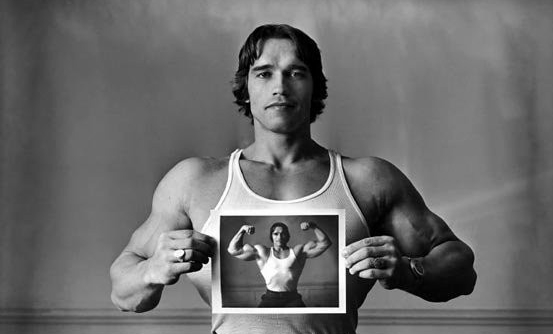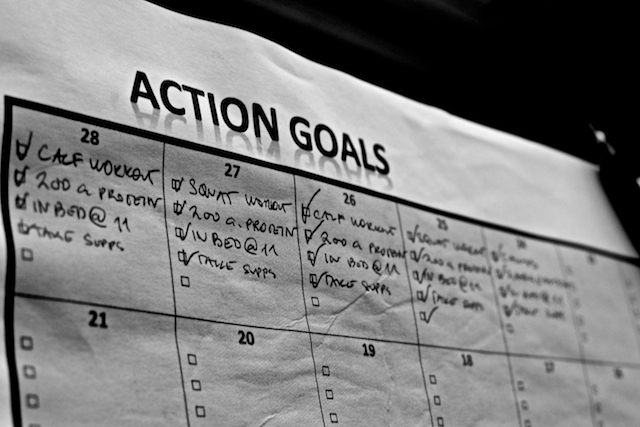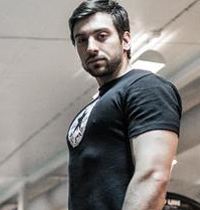Why You Need To STOP Setting Goals


By Dr. Bojan Kostevski
Today, I’m here to share a secret with you.
I realize that saying this might make other fitness professionals condemn me to rot in a dark cave somewhere with no company but the voice of my own neurotic conscience, but I can no longer keep my mouth shut.
I HATE GOAL SETTING.
Yeah, I said it.
I’m about to tell you why I believe traditional goal setting might be bringing frustration and anxiety upon you and decreasing your quality of life. Furthermore, I’ll show you how a simple focus shift can fix the problem in a matter of minutes, resulting in better results in the gym and living a more enjoyable life in the process.
To illustrate my point, let me start by sharing a very personal story with you.
Excitement and Optimism
 I remember standing in front of the mirror after a great workout, carefully examining my body. It was in September of 2008.
I remember standing in front of the mirror after a great workout, carefully examining my body. It was in September of 2008.
The shoulders were thick and solid, as was my back. Arms were a little too small and upper chest not protruding in the horizontal plane as much as I desired. Legs had an arching sweep but a little more separation and a higher hamstring-to-quadriceps ratio would do me good. Lastly, I forced myself to look at my calves, knowing how I wouldn’t be impressed.
This was about to change.
Soon, my chest would protrude in a shelf-like manner beneath my winter parka, like J-Lo’s behind in undersized denim leggings, and my tumorous calves would require an area code of their own.
On a piece of high quality paper, using the fountain pen I’d inherited from my grandfather, I managed to extravagantly verbalize the details of my desired physique.
It was a very sentimental moment for me.
I made the goals concrete and vivid, with a set deadline to spur immediate action. I had defined goals of what my limbs would measure 12 months later, colorfully imagining the measure tape stretching over my bulging biceps as my serotonin-squirting brain filled me with an immense sense of joy and pride as I reached my goal.
I closed my eyes and visualized my future self strolling down the beach, walking around in the head-turning body I was born to have, finally being the man I was born to be.
Man, was I in for a disappointment.
Failure and Insight
In the summer of 2011, as I was moving to a new apartment, I found the goal sheet.
Not only had I failed to reach any of the goals (36 months later), despite working exceedingly hard, but I realized why I had failed: The words in fancy lettering were nothing but a best-case scenario, a dream. Let it be said that while dreams are important, they are not actionable.
You Are Not Very Good At Thinking
Variations of this outcome-based goal setting technique are described in the “Goal Setting” chapter of every fitness book you’ve ever read. Intuitively, it makes perfect sense, doesn’t it?
You must have a concrete and vivid picture of how you eventually want to look, assess your current bodily state, and define the distance between your current and future self. You have to keep this mental picture in your mind at all times. Every rep of every set, every bite of dead flesh entering your gastrointestinal tract, staying hungry until you eventually reach your end goal in the deadline you’ve set for yourself.
As rational as it might sound, the technique is useless.
Your emotion-driven brain is very susceptible to flawed and biased thinking and despite your best interests, it’s highly irrational. Next, we’ll examine some of the shortcomings of the human mind to better understand why outcome-based goal setting techniques are bound to fail.
Self-Control and Delayed Benefits
Exercising and dieting have up-front costs with severely delayed benefits, thus seriously testing your capacity for long-term self-control. The reverse is true for smoking, alcohol and binges at Asian all-you-can-eat buffets. We get pleasure now and suffer consequences later and being humans, we love immediate pleasure and vastly ignore delayed costs.
Absence of Feedback
Rapid response is crucial to provide positive reinforcement and keep you on track. When practicing basketball shots it is essential that you see which balls enter the basket and which don’t, so you can adjust accordingly. Outcome-focused fitness transformations provide a very abstract and delayed feedback system. Physique changes simply happen too slow and often in a nonlinear and unpredictable fashion. Essentially, with traditional goal setting, you’re throwing basketballs into the dark.
The Planning Fallacy and Randomness
Lastly, humans have a tendency to underestimate the required time to project completion and ignore the role of randomness in predicting the future. Processes, including your fitness transformation, always take longer then you expect.
Attaining that dream body you so vividly picture on your retina requires a combination of all those things: a high level of discipline, sacrifice and self-control, under a very long (and often underestimated) length of time. The daily costs for the desired benefits in a very distant and unpredictable future, relentlessly antagonize one during a time which positive feedback is very limited. Due to these shortcomings of the human mind, your outcome-based goals transform your useful will power into an autoimmune disease, doing more harm than good. The result? Frustration, anxiety and doubt in one’s abilities.
Luckily, there is a cure. Stay with me.
Finding Flow
The simple solution requires a shift in perspective. In a few simple steps you can turn your mental auto-focus system off and manually rotate the focus ring, aiming your attention away from the abstract wanted outcome to the actual process that will take you there.
Furthermore, if you ever are to achieve your end goal, you’ll be stuck in the fitness game for a long time so you might as well maximize your chances of enjoying it. Your training can become a sensation of Flow; a term popularized by the famous psychology professor Mihaly Csikszentmihalyi.
Flow is a mental state in which a person involved in an activity is fully submerged in a feeling of energized focus, complete involvement, and enjoyment in the process of the activity. Action and awareness are merged with total absorption in what one does.
No matter who you ask, the Flow experience is described in almost identical terms regardless of the activity that produced it. Athletes, artists, scientists, surgeons, and writers all describe the most rewarding experiences with very similar words. Activities that produce the sensation of Flow have:
- Clear
goals every step of the way
- Immediate
feedback to one's actions
- A perfect balance between challenge and skill, thus balancing the fine line between frustration and boredom.
I’m sure that you can see how trying to maximize these factors, and thus increasing the probability for a Flow-like experience, also acts as an antidote to the shortcomings of the human mind mentioned earlier.
To stay (sane) in the quest for physical perfection, I believe you need to enjoy the training for what it is, not for the outcome you expect 5 years from now. Swinging those weights can become an intrinsically enjoyable, Flow-like experience, worth doing for its own sake.
Time to turn that focus ring.
Turning Dreams Into Actions

So, you have a dream. A vision of what you want to achieve with your training. As I’m sure you understand by now, dreams alone won’t get you anywhere.
Time to shift your perspective.
Know your direction but focus less on defining exactly WHAT YOU WANT, and more on WHAT TO DO. Define the specific short-term actions that will maximize your chances of one day reaching your outcome-based goals. Write them down and then focus all your attention on your Action Goals, thus shifting the focus from the wanted outcome to the process.
Ask yourself the following:
What specific actions can I take to maximize the chances of ever reaching the body of my dream? This week? Today?
To give you an example, whereas my goal for my calves used to be: add 2 cm to calf circumference in 12 months, today I’d start by asking myself the following:
What can I DO to maximize the chances of increasing my calf size?
Then I’d set the goal for the week as following: This week, my goal is 3 calf workouts (mon, wed, sat) and 2 heavy squat sessions (tue, sun), while eating 200 grams of protein daily and getting at least 6 hours of sleep every night.

Every Sunday, on my action sheet or in a calendar, I write the action goals down on their respective days, check them off during the week as I go, and then evaluate and reward every completed action goal the following Sunday. I then set new action goals for the upcoming week in the same manner.
Why It Works
Note how this focus shift reduces the distance between cost and pleasure from 12 months (vastly underestimated time) into a week. It turns an abstract and distant outcome-goal into an immediate actionable goal that is 100% in your control and provides the possibility for rapid respone, making it possible through trial and error to correct the basketball shots of your fitness journey, both acting as antidote for the autoimmune human mind and maximizing the chances for Flow-like training experiences.
For a much more in-depth and detailed step-by-step guide to setting your action goals check out this free Complete Goal Setting Manual.
Wasted Times And The Last Move
It took me another 2 years and one more move to find the sheet of paper again. By that time, I had met all my goals, but instead of one burst of positive feedback 5 years later, I’d been enjoying every single day, training because I love it.
By stepping out of the best-case-scenario, by matching your outcome-based dreams to actionable goals that are in your control, you can turn your journey, and eventually your life into a Flow-like experience and, eventually, reach your dreams by trial and error. While it might seem like a waste of time, to learn and evolve in any domain, trial-and-error is a necessity, so you might as well learn to enjoy it.
Today, the ‘wasted time’ in the gym is my way to filter out the rest of the world. It’s my psychotherapy and my meditation. Gym time is MY time, and over the years, the iron has shaped me, both physically and mentally, into the man I am today.
Here’s one last piece of advice for you: don't be so goddamn afraid of wasting your time. Walk for the sake of walking. Read for the sake of reading. Lift for the sake of lifting. Because, in the end, what else is life than a collection of wasted times? More often then not, in the wasted times, retrospectively, is where all the magic happened.
Today I love the process of training, and lift heavy because it’s a part of who I am. A chest the size of J-Lo’s butt in undersized denim leggings is nothing but a (very) nice bonus.
References and recommended reading
Thaler, Richard H.; Sunstein, Cass R. (2008). Nudge: Improving Decisions about Health, Wealth, and Happiness. Yale University Press. ISBN 978-0-14-311526-7.OCLC 791403664
Kahneman, Daniel (2011). Thinking, Fast and Slow. Macmillan. ISBN 978-1-4299-6935-2.
Csikszentmihalyi, Mihaly (1990). Flow: The Psychology of Optimal Experience. New York: Harper and Row. ISBN 0-06-092043-2
ABOUT THE AUTHOR

Dr. Bojan Kostevski is a former personal trainer who turned his passion for health and fitness into a medical degree. Working as a physician and online trainer he follows his original interest in preventive medicine and uses his passion to educate himself and others around him how to achieve what most of us are seeking: confident and obsession free personalities with strong, good-looking physiques. Check out his site http://www.Lift-Heavy.com for more information.
Website: http://www.Lift-Heavy.com
Facebook: https://www.facebook.com/bkostevski
Twitter: https://twitter.com/BojanKostevski
